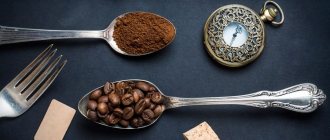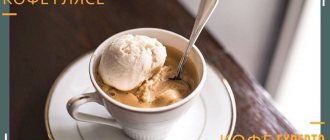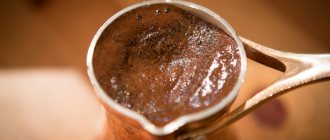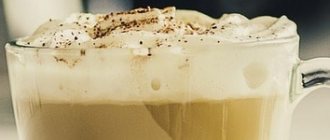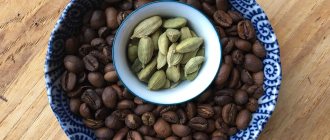History of the origin of the drink
The Ethiopians were the first to prepare coffee beans. According to legend, even BC. The shepherd noticed that coffee beans had a stimulating effect on goats. He told about this in a monastery nearby. The monks tried the drink and felt the tonic effect, so they took it before evening prayers.
They experimented, roasted grains, and came up with cooking methods. At first, Ethiopians drank coffee only on special occasions, but gradually the frequency increased, and it became the hallmark of the country.
Over time, the drink was brought to Yemen by nomadic tribes and traders. The Arabs brewed coffee from the pulp of unroasted beans, so it turned out light. A method of preparation close to ours, oriental coffee was invented in the Middle East in the 12th century. Under the reign of Peter I, the drink firmly entered the culture of the nobility of that time and gradually spread to the common people of Russia.
How to make oriental coffee
Classic cooking method
Oriental coffee is prepared from very finely ground coffee beans, almost to powder. This is necessary, firstly, so that a thick foam forms in the drink, and secondly, to avoid the grounds squeaking on the teeth. Since ground coffee quickly loses its qualities (smell, taste, essential oils), it is better to grind it yourself immediately before preparing the drink.
For sufficiently fine grinds, it is better to use a burr coffee grinder with a powerful motor and, best of all, ceramic burrs. Due to the inertness of the material, the ceramics do not heat up, so there is no danger of burning the coffee.
When preparing coffee using the “oriental” method, it should never be boiled. You should not drink over-boiled coffee. Therefore, it is cooked over low, low heat, or even better, on hot sand, which will warm the coffee to the desired temperature, but will not allow it to boil. There are special devices for making coffee on sand.
At home, you can use a deep frying pan (preferably cast iron), into which you pour either clean sand or sand mixed with salt. The frying pan with sand is placed on the fire, and the Turk (cezve) is buried in the sand, where it slowly heats up.
Other cooking methods
Among the many options for preparing oriental coffee, Turks pour a little granulated sugar into the bottom and put it on the fire. After the sugar turns brown, it is poured with water. At the same time, you need to make sure that the sugar does not burn, otherwise the coffee will have a bitter aftertaste.
Coffee and sugar to taste are poured into the Turk, and hot water is poured in (although if you break the technology insignificantly and pour in cold water, then nothing bad will happen). Then the Turk is buried in the sand or placed on low heat. When using sand, you need to take into account that the sand at the bottom is hot, and on top it is only warm, so the temperature of the top layer of sand should not mislead you. After a few minutes, foam appears on the surface of the coffee. This is coffee foam, not water foam from boiling.
The turk is removed from the sand or removed from the heat (depending on the cooking method), and the foam is allowed to settle. They bury the Turk again in the sand or put it on fire, again allow the coffee foam to rise, and then allow it to settle. This is repeated several times. This method is quite labor-intensive and time-consuming, but the results are worth it. You can add spices to the finished coffee to taste.
Features of the Arabic drink
Coffee is prepared by hand, just like centuries ago. A real oriental drink cannot be prepared in a coffee machine. The fact is that the traditional recipe uses very fine grinding. It's essentially coffee dust.
Bitterness and rich taste are the hallmark of oriental coffee. Arabs always add spices to their coffee, such as cardamom. This makes the drink aromatic and spicy. Ideally, different types of grains are used. When fried, they have a light yellow color, which is achieved due to exposure to water vapor. A blend of Arabica and Robusta directly affects the richness.
What is oriental coffee?
Depending on the amount of sugar used during its preparation, this type of coffee can be bitter, sweet or very sweet. The quality of the grind and the amount of water and coffee create room for variation: the drink can be thinner or thicker.
Spices that are traditionally used to make oriental coffee: cinnamon, cardamom, cloves, nutmeg, black pepper, garlic, salt. They give the drink a unique “zest”.
Drinking culture
According to Eastern traditions, coffee is served according to seniority, from oldest to youngest. The host serves his guests at least 3 cups of drink. Asking for another cup is considered bad manners. You just need to accept gifts from the owner.
Only cups made of ceramics and porcelain are suitable for serving. Arabs believe that the taste of coffee will deteriorate if served in paper or plastic containers.
Drink coffee in small sips, washing down each sip of coffee with cold water, preferably with ice.
How to drink coffee the Eastern way
Oriental-style coffee is poured into small coffee cups simply at the table, without straining, with grounds. Cold water is supplied separately. Sometimes a few drops of water are added to the cup to help the grounds settle faster. It is customary to drink oriental coffee in small sips and wash it down with cold boiled water. Before drinking coffee, Arabs usually drank some water.
The main uniqueness of oriental coffee is the way it is consumed. The drink is served to the table directly in the cezve and poured into cups without straining. The foam that covers the top of the coffee plays a special role: it is the foam that is put into the cups first, and only then the drink itself is poured.
The peculiarities of making oriental coffee determined the lack of additional accessories. Neither sugar (since it was already added during cooking) nor spoons (since there is no need for them) are usually included with this drink. They drink oriental coffee from special small cups with a capacity of 60-70 ml, thick ceramic or thin-walled porcelain. Drinking oriental coffee from tea cups or espresso demitas is considered bad manners.
There is another, special option for serving coffee in the oriental style - the so-called coffee set. It includes a Turk, a cup, a saucer and a spoon. All this is served on a small separate tray. A glass of water is placed to the right of the cup, and a sugar bowl is placed to the left.
Oriental coffee can be consumed and served a little differently. First, skim off the foam with a spoon, then pour the coffee into cups and put the foam on top. Etiquette dictates that such coffee be served to the guest in a cup, and a glass of cold water placed on the left.
(5 likes)

Flatwhite Flat white
Previous post

Robusta
Next entry
Spices in oriental coffee
In Europe, coffee is also drunk with spices. Just look at the popularity of cinnamon. But if you take cardamom, its percentage in a cup is 10%. Eastern residents add much more cardamom, noting its beneficial properties for the body. For example, the spice cleanses the blood, improves the functioning of the heart and blood vessels, and also tones the body well.
Cardamom goes well with cinnamon, so you can safely put ground cinnamon in oriental coffee, or in the form of a stick. Cinnamon is also very beneficial for health. It can even lower your blood sugar levels. The spice is added to ready-made coffee.
Cloves and star anise will also not spoil the taste of oriental coffee. However, in this case, you should not combine them with cardamom; you need to replace it. A few grains of star anise allow you to feel the spicy taste.
Star anise is mixed with coffee in Turk. To reveal the full aroma, the finished drink can be covered with a lid for a few minutes, and only then start drinking.
How to brew coffee the Eastern way
Despite the fact that oriental coffee can be prepared according to various recipes, the technology remains the same.
When starting to prepare, you need to remember that this type of drink will require time and patience. It should be prepared without haste and in a good mood. The drink cannot be boiled; it is brought to the desired temperature using very low heat.
In addition, you need to take a Turk and good quality water; you should not take boiled water for cooking. The grain grinding should be as fine as possible.
Ingredients for one classic serving:
- Ground grains – 10 grams.
- Sugar – 10 grams.
- Water – 105 grams.
The calorie content of the finished drink is 70 Kcal.
Oriental or Turkish coffee?
Making Turkish coffee is the most common option; it is often also called Turkish or Arabic coffee; in essence, they are the same drink. Due to the fact that the preparation is carried out in an open container, you can independently give the drink an individual taste using a variety of additives.
By adjusting the amount of sugar, you can make oriental coffee very sweet, moderately sweet, very bitter - it all depends on personal preference. The amount of water or grind size affects the thickness of the drink, and spices can give coffee a unique aroma and taste. Typically, nutmeg, cloves, cardamom, and cinnamon are used for an oriental drink. You can add an original taste to the drink using additives such as salt, garlic or black pepper.
Making coffee without special equipment
If you want to prepare a coffee drink according to an oriental recipe at home, it is not at all necessary to purchase expensive equipment. The special apparatus can be replaced with a homemade frying pan.
Be sure to read: Coffee and tea in one glass: recipes
The algorithm for preparing an invigorating drink in a frying pan is as follows:
- Take a frying pan with high edges, preferably cast iron, thick-walled. But not with a Teflon coating - otherwise it will be damaged by sand.
- Pour quartz sand into a frying pan and set it to heat up. And uniform heating of the sand is achieved by constantly stirring it.
- While the sand is warming up, you can start preparing the coffee mixture.
- When the sand has warmed up well, put the Turk on our frying pan and submerge it slightly - 2-3 cm, but so that the bottom does not touch the frying pan itself.
- You need to brew coffee according to the standard algorithm: wait until the foam rises several times, and you can pour the finished drink into a cup. And don’t forget to warm up the cup before doing this by pouring boiling water over it.
The taste of this drink amazes with its richness and density, and the aroma simply immerses you in the secret world of the East.
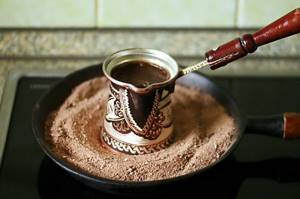
How oriental coffee is served
A glass of cold water is served on the table with oriental coffee. It helps you better experience all the benefits of the drink. Therefore, be sure to first take a sip of water, and then a slow sip of coffee. A glass of water is placed to the right of the coffee cup, and sugar to the left. The drink is poured from the Turk into coffee cups placed on the table. They should be ceramic or porcelain and small in size.
These are, perhaps, all the secrets of oriental coffee. Knowing one, the most important recipe for making coffee in the oriental style, you can diversify it with your own additions.
Classic cooking method - subtleties and algorithm
The traditional recipe for Arabic coffee was brought to the present generation by the descendants of its connoisseurs from the countries of the East. Then the drink was brewed in dalls, monuments to which were erected in many countries around the world.
It was believed that every bride should be able to brew Arabic natural coffee. For example, in the Levant, the economic skills of girls of marriageable age were assessed based on the taste characteristics of the drink served.
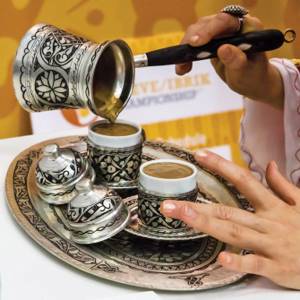
The correct technological map for preparing real Arabic coffee is as follows:
- 10 g ground coffee beans;
- 105 ml of clean water;
- sugar to taste.
The preparation algorithm consists of several stages:
- Sugar is placed in a cezve and poured with water, bringing it to a boil.
- A mixture of ground coffee beans is placed in sugar syrup.
- While stirring the drink, wait for the formation of a coffee “cap”.
- Remove the coffee from the heat until it boils.
- Repeat the procedure several times.
- Remove the foam with a spoon.
The drink is poured into cups and foam is placed on top.
You might be wondering: Can you drink coffee with honey?
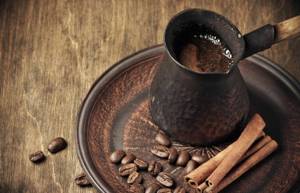
The classic oriental coffee recipe guarantees a strong and invigorating drink without bitterness at home. To brew a drink that is milder in taste and less strong, add water to it at the boiling stage of the syrup and only then add coffee.
Spices and herbs are added to the drink according to taste, but more often the traditional version is used - cardamom.
With cinnamon, chocolate, almonds - recipes in the best oriental traditions
Cardamom goes perfectly with cinnamon, so when choosing the version of Arabic coffee with cardamom, you can safely add ground spice to it or, in the classic version, in the form of a stick. Cinnamon helps lower blood sugar levels and can be included in the diet of diabetics. Add spice to the drink that is already prepared and poured into cups.
As an option, you can also consider a recipe for coffee with cloves or star anise. The standard preparation technology does not differ from the technology for brewing Arabic coffee in the classic version. The only change is star anise. A few grains will be enough to feel the effect.

Spice is added at the coffee brewing stage, mixing it with ground beans. To allow the aromas to develop, it is recommended to pour boiling water over a mixture of coffee and spices (cinnamon and cardamom are used along the way) and let it brew for several minutes.
Oriental coffee is brewed in this version over low heat, thus delaying the moment of boiling, allowing the aromas to fill the entire room. A teaspoon of cognac will add piquancy to the finished drink, making it rich and sophisticated.
You might be interested in Warming Mexican coffee Olla
A worthy option is Arabic Turkish coffee with the addition of nutmeg. The cooking principle is no different from the traditional one. The only thing is that along with cardamom, a little nutmeg is added to it. It is important not to overdo it with the spice, given its special astringent taste and pungency.
Nutmeg gives coffee new properties - tonic. A drink in this composition activates the brain and energizes you.
As an option, it is worth considering a recipe with the addition of a few almonds. In this case, oriental coffee is prepared by chopping nuts mixed with 50 ml of milk in a blender. The prepared mixture is heated, sugar and cardamom are added and only then mixed with coffee brewed separately on sand or over low heat.

For chocolate connoisseurs, the recipe with its addition to coffee will seem the most interesting. The drink is prepared in a Turk, according to tradition, first adding a coffee mixture with cardamom and cloves, filled with water. The drink is heated without boiling, then mixed with pre-whipped milk and melted dark chocolate (50 ml/50g).
All of the above ingredients added to oriental coffee will help in the fight against excess weight. For example, cardamom has been known since ancient times as a means for weight loss. The spice activates metabolic processes, speeding up metabolism.
Coffee prepared according to the Kenyan recipe
Eastern countries love spicy seasonings. Perhaps the most spicy drink is prepared in the Republic of Kenya. The state of Kenya is located in East Africa. Kenyans add a lot of spicy spices to their food. They believe that spicy food can rid a person of the influence of evil spirits. So they often prepare a drink from coffee beans with “light”.
Kenyan coffee drink
Ingredients:
- water - 125 ml;
- ground coffee powder - 9 g;
- sugar - 15 g;
- pepper (cayenne) - 0.7 g;
- allspice - 1 pc.;
- cardamom - 0.7 g
Preparation of Kenyan coffee according to the oriental method:
- Pour all bulk products into the pot, except for spices. Stir, pour cold water.
- Place on low gas; when the water is hot, add spices. Bring the liquid to a boil, or rather until foam appears.
- Remove from the oven for a few tens of seconds, repeat the process several times until the foam becomes thick and light.
- Then remove the cezve from the heat. And first fill the cup with foam with coffee, only then pour it.
You should drink it in small sips, you can even wash it down with water. This drink is not for everyone and it has contraindications.
Spicy coffee should not be consumed by hypertensive patients or people with gastrointestinal diseases.
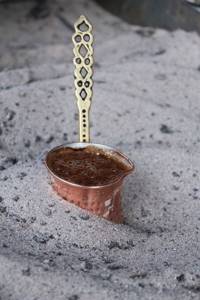
Where in St. Petersburg they brew oriental coffee
Frida
st. Tchaikovskogo, 57
Frida is a real paradise for coffee lovers. A unique space with demonstrated tea and coffee skills and Mexican signature cuisine. Here, oriental coffee is presented in dozens of options: from Arabic coffee with cardamom and cinnamon to “Sheikh in Love” with red wine and “Laura’s Dreams” with brandy and lemon zest.
Romantic dates or family dinner: the most popular restaurants in St. Petersburg for two

Addis
Nevsky Ave., 120
“Addis” is called not just a workshop of artisanal coffee, but a real interactive museum. Coffee here is brewed in cezves*, coffee pots and coffee makers. The menu includes classic coffee brewed according to oriental recipes, as well as Vietnamese and Ethiopian coffee. For example, the latter is brewed in a clay coffee pot Jebene, and served in national dishes with a portion of popcorn.
*Cezve is a metal cone-shaped vessel with a long handle for brewing coffee.
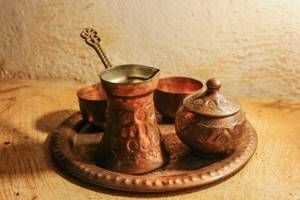
Sicaffe on Gorokhovaya
st. Gorokhovaya, 2
The Sicaffe Coffee & Strudels menu includes a wide selection of coffee and tea, pastries and desserts. They are especially proud of their strudels - the dough in them is nominal, and the fillings are varied: from fish to cottage cheese and cherries. The Turkish coffee we are interested in is also brewed here, prepared by boiling ground coffee beans in a Turkish coffee pot. A great place in the city center, where they also play piano or saxophone every evening.

Abrikosov
Nevsky Ave., 40
In addition to the unique antique interior, people from all over St. Petersburg come here for quality brewed coffee. Abrikosov is one of the few places in the city where they brew coffee on sand (with cinnamon, nutmeg and cardamom) the way Asian and North African caravans do in the desert. And in the summer it is especially pleasant to sit on the veranda overlooking the Gostiny Dvor and take handmade sweets or cakes with your coffee drink.
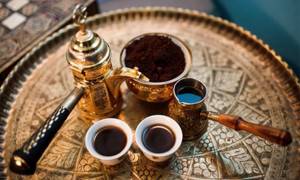
Coffee Museum
emb. Voskresenskaya, 14
weekdays, weekends 300
At the Coffee Museum, visitors will not only be told everything about coffee culture, but will also be invited to take part in various coffee tastings. For example, at the “5 Flavors” tasting show, participants will learn how the same type of coffee, prepared in five different ways, changes its taste, including Turkish coffee.
Spice Museum
Bolshoy V.O. Ave., 6
weekdays, weekends 300; pensioners, schoolchildren 200; students 250
In the only “Spice Museum” in Russia, you can enjoy not only inhaling the fragrant exhibition samples of spices, but also experiencing the oriental taste of sweet dates, baklava and churchkhela with coffee brewed in a Turk on sand with cardamom or a blend of Arabic spices.
Kashmir
st. Bolshaya Moskovskaya, 7
With a rich tea collection, the Kashmir cafe also attracts avid coffee lovers. Here, coffee is brewed for visitors on hot sand and, according to Eastern traditions, it is brought to a boil three times. The menu includes both classic oriental coffee and Arabic coffee with the aroma of oriental spices, as well as, for example, Colombian coffee with orange zest and vanilla.

Coffee maker on Engelsa
Engels Ave., 124, building 1, lit. A
The Coffee Varim chain operates in two formats: coffee stations, where you can take coffee with you, and full-fledged coffee shops. The latter offer an expanded menu of drinks from classic cappuccino to Turkish coffee on sand, as well as a small selection of homemade desserts.
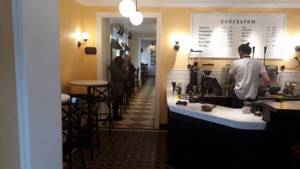
Own room
st. Dekabristov, 55
Next to the Mariinsky Theater and New Holland there is a cozy coffee shop with homemade pastries, breakfasts and soups. People often experiment here in search of unusual flavor combinations. For example, oriental coffee is brewed in a Turkish pot with cinnamon or cardamom. And the owner of the establishment herself bakes cranberry pie, clafoutis with cherries and “Napoleon” according to a proven family recipe.
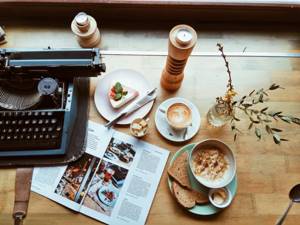
Theura
st. Rubinshteina, 9
Another vegetarian cafe with a serious approach to coffee. In Turk here, visitors are prepared to brew Oriental coffee with or without milk, Arabic coffee with cardamom and cinnamon, Persian coffee with honey and salt, Colombian coffee with orange zest and cloves, Jamaican coffee with mint, cinnamon and rum and even Normandy coffee with apple juice, spices and sambuca.

Subscribe to us on Google News and Yandex.Zen: more interesting things every day. All interesting events are in our weekly newsletter. Categories: Restaurants and cafes Top in St. Petersburg







